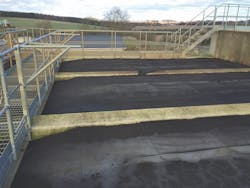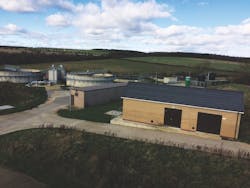About the author:
David Shepherd is sales manager for De Nora Water Technologies. Shepherd can be reached at [email protected] or +44.0.7770.934326.
Due to forecasted commercial and residential developments in the catchment area and the planned introduction of more stringent discharge consents, Northumbrian Water in northeast England announced in November 2009 a plan to enhance and extend the existing Bowburn Sewage Treatment Works (STW) in County Durham.
The aim was to meet the increased demand caused by the rise in population serviced by Bowburn to approximately 13,000—Northumbrian Water provides 2.7 million residents with water and wastewater services—while at the same time delivering quality improvements to the effluent discharged to the rivers and local environment.
Besides an increase in capacity, the plant was redesigned to incorporate a third stage of treatment and chemical dosing to meet tighter ammonia level and phosphate removal requirements as well as the removal of total suspended solids (TSS) and
biochemical oxygen demand (BOD).
Biological Reactor & Filter Selection for Sewage Treatment
De Nora Water Technologies was selected by specialist contractor Byzak Ltd. to design, manufacture, commission and install three De Nora TETRA nitrifying submerged aerated filters (NSAF) and three De Nora TETRA DeepBed filter cells as part of the extension to the existing processes. The tertiary filtration technology was installed in late 2011 and performance trials were successfully completed in January 2012. Those trials showed significant measurable improvements in the quality of effluent, despite the increased volumes being treated. In addition, further environmental and amenity improvements have been noticeable due to a reduction in levels of suspended solids and phosphate.
Since the plant was commissioned in 1964, the quality of effluent has been steadily improved with the latest stringent requirements being 10 mg/L BOD, 15 mg/L TSS and 3 mg/L ammonia based on treating 5,000 cu meters of water per day.
How the Technology Works
De Nora TETRA NSAF is an upflow, fixed-film biological reactor that generates minimal solids that would require handling and disposal following treatment. The technology is robust and adaptable and can be engineered in a range of sizes from small modular units suitable for above or below ground construction to custom configurations for large plants. The system represents one way of achieving ammonia standards down to as low as 1 mg/L on a 95 percentile basis. The filter requires no backwashing.
The TETRA DeepBed filters provide solids and related phosphorous removal to meet stringent limits below 0.2 ppm. The system is a downflow sand filter with a high loading capacity, making it ideal for handling peak loads. A granular filter is used for removal of TSS from secondary treatment effluent using a media depth of at least 4 ft at a filtration rate of more than 2 gpm per sq ft. Coarse media normally is used to encourage deep penetration of solids into the media bed. This allows for longer filtration runtimes. Simultaneous air and water backwashes are used to ensure filters are cleaned properly.
With the DeepBed filters, secondary effluent enters a filter at the top and is evenly distributed across the entire filter. As the wastewater passes through the filter bed, suspended solids are retained and stored in the voids between the sand grains. Accumulation of solids will decrease the void space in the filter media bed. As the filtration cycle progresses, additional energy is needed to maintain the required filtration rate indicated by an increase in head loss. When the head loss reaches the maximum available level and the filtration rate cannot be maintained, the filter must be removed from service and the media cleaned.
Results of Bioreactor & Filter Installation
Installation of these systems has delivered a reduction of 35% in phosphate levels and reduced the volume of suspended solids from entering the river networks by almost 500 lb, thereby improving the quality of effluent discharged to an area of exceptional natural beauty.
This has had a significant positive impact on the overall health and amenity value of the river systems as there are fewer solids to block out light and potentially increase silt in the river system. In addition, reductions in the levels of phosphates in the water have tackled potentially harmful and toxic algae growths that deprive the river of oxygen.
The investment by Northumbrian Water has reduced the variability in effluent quality, so the levels discharged to the environment are not affected by season, weather or other aspects.
Frank Errington, treatment works manager at Northumbrian Water, said the positive impact made by the installation of the equipment took him by surprise when he first visited Bowburn STW following completion of the improvement works.
“[Before] TETRA NSAF and DBF, Bowburn STW had variable treatment capabilities mainly seen around weather changes and conditions. The predicted catchment growth expansion would have potentially created situations where the works compliance standards may have been breached,” he said.
The installation at this strategic sewage treatment plant has also provided extra capacity to support the economic regeneration of this area of northeast England, and ensures compliance with European legislation and local environmental action plans.
Since completion of the plant, Northumbrian Water has continued to invest to improve the quality of water sources in the region and has achieved 100% delivery of its Asset Management Plan National Environment Programme, according to data contained within the Environment Agency’s report on water companies’ performance in 2016.
“The performance on site has been excellent since the installation of the NSAF and DBF,” commented Errington. “Although the expected growth in population within the catchment area has yet to be fully realized, the required compliance standards are being easily achieved at present with suspended solids and phosphorous at times being so low to be classed as not traceable.
“My first viewing of the NSAF and DBF cells at Bowburn STW was in December 2016 when I was appointed treatment works manager for the area,” he added. “I was amazed then, and still am to this day, by the quality of effluent. At the time, I commented that ’the final effluent looks like tap water.’”

